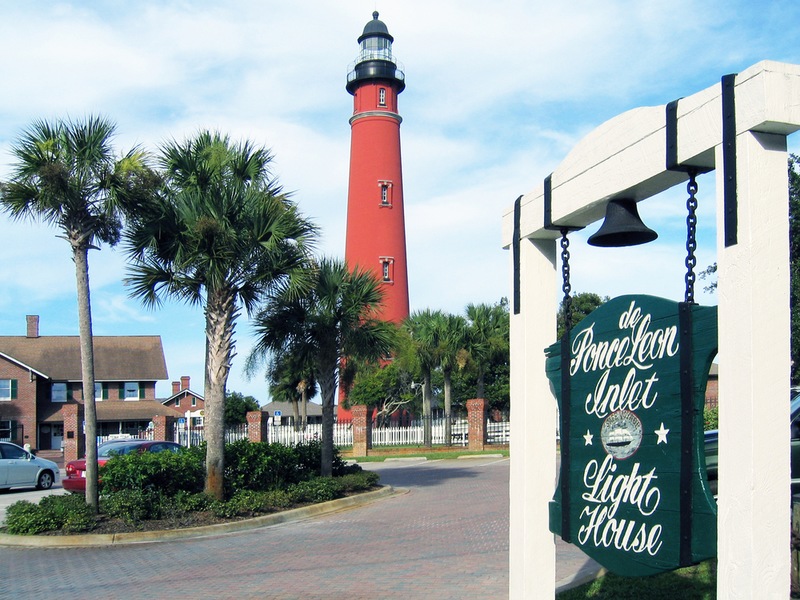
For such a historic location, it should come as no surprise that there is actually a hefty amount of history behind the naming of Ponce De Leon Inlet. Unbeknownst to many, the waterway from which the lighthouse takes its name was called Mosquito Inlet from the early part of the First Spanish Period until the late-1920s! Let’s journey into the past and discover the history of this fascinating place.
Ponce De Leon Inlet (commonly referred to as simply Ponce Inlet) is named after Juan Ponce De Leon, the famous Spanish conquistador who is credited with "discovering" Florida in 1513. Although it is unknown if De Leon actually entered the inlet while sailing along Florida's east coast , Spanish documents from the late-1560s/early-1570s clearly identify the inlet as Mosquito or "Los Mosquitos". Mosquito is a Spanish word for "little fly."
One of the earliest references of the inlet being named Los Mosquitos can be found in a report submitted to the King of Spain in 1569 titled Memorial on Four Port of Florida Presented to His Majesty by Captain Antonio De Prado. Within the document Captain Antonio De Prado writes "Ten leagues from the fort of Matanzas is the port of Saint Simon, which by another name they call Mosquitos; and all the Indians of that district are our enemies and friends of the French; when there are ships of corsairs, they make great smoke signals, giving warning there are ships, so that the Indians may assemble. And because of this there must be in that fort two hundred soldiers: one hundred as a guard for the fort itself, fifty as a guard for a blockhouses that is to built in a place they call Nocoroco, which is situated between two rivers, one of which goes to the port of Matanzas and other to that of Mosquitos."¹
A second historic reference of the inlet being named Mosquito Inlet by the Spanish can be found in the historic record of a journey taken by Pedro Menendez Marquez along Florida's east coast in 1573. Marquez was a nephew of Pedro Menéndez de Aviles, the founder of St. Augustine's and first Adelantado (or Governor) of Florida. Marquez was serving as Lieutenant Governor of Cuba under Aviles at the time of his journey. Marquez's chronicler recorded the following description of Mosquito Inlet during his 1573 journey along the coast:
"The Cape of Canaveral is in twenty-eight degrees and a quarter, and ten leagues therefrom is the bar of Mosquito, which at ebb tide has a depth of one vara* and a half and at high tide a good two varas and a half. There are sand dune north and south. He (Marquez) entered east and west by a very narrow entrance, wherefore he came to the sand dune on the north, and the shoal to starboard; and once within he went to the port side, because the river could be sounded, and was unnavigable toward the south; until he came to a high sand dune on the port side, showing a beginning of a grove where there are some fish-weirs and there he anchored."²
It is interesting to note that Marquez would later chosen to serve as the third Adelantado of Florida. Appointed in in 1577, Marquez remained Florida's Governor until 1594. His many accomplishments during this time included solidifying Spain's foothold in what is now the southeastern United States, helping maintain Spanish control of the Western Caribbean, quelling Native American uprisings, evacuating St. Augustine prior to the attack of Sir Frances Drake in 1586, and initiating the rebuilding and reinforcement of the sacked port city using a recently discovered sedimentary stone called coquina.
Naming the inlet after the mosquito should have come to no surprise to anyone visiting the area given the swarms of biting insects they would have invariably found there during most of the year. In fact, the central portion of the Florida peninsula stretching west from the Atlantic coast to nearly the eastern shore of Tampa Bay and south from Matanzas Inlet to Hillsboro Inlet was originally called Mosquito County. The large tidal estuary located just north of Cape Canaveral was named Mosquito Lagoon and the inland waterway that parallels Florida's east coast from the Tomoka Basin near the Volusia/Flagler county line south to Merritt Island was originally named the Mosquito River.
The Mosquito River was eventually divided into two halves during the English period, becoming the Indian River from Mosquito Inlet south and the Halifax River from the inlet north to the Tomoka River Basin. The mid-to-late-1800s also witnessed the division of Mosquito County into the smaller, more manageable counties of Flagler, Volusia, Brevard, Orange, Polk, Lake, and others. Mosquito Inlet kept its name until the late 1920s when it was renamed Ponce de Leon Inlet in an effort to attract potential home buyers to the area. The Florida land-boom was in full-swing at the time and real estate developers undoubtedly found marketing land named after the biting insect a tough sell. They thought Ponce de Leon Inlet sounded much more appealing than Mosquito Inlet. The Florida Legislature agreed and officially renamed the inlet in honor of Juan Ponce de Leon in 1928. Only Mosquito Lagoon retains its historic name to this day.
*A vera was unit of measurement used by the Spanish approximately three feet in length.